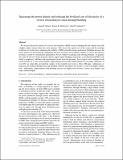Increasing the power density and reducing the levelized cost of electricity of a reverse electrodialysis stack through blending
Author(s)
Weiner, Adam Michael; McGovern, Ronan Killian; Lienhard, John H.
DownloadRED_Blending_Desalination.pdf (1.798Mb)
PUBLISHER_CC
Publisher with Creative Commons License
Creative Commons Attribution
Terms of use
Metadata
Show full item recordAbstract
We increase the power density of a reverse electrodialysis (RED) stack by blending the low salinity feed with a higher salinity stream before the stack entrance. This lowers the capital cost of the system and the resulting levelized cost of electricity, enhancing the viability of RED renewable energy generation. Blending increases the power density by decreasing the dominating electrical resistance in the diluate channel as well as the effective resistance caused by concentration polarization, but not without sacrificing some driving potential. To quantify this trade-off and to evaluate the power density improvement blending can provide, a one-dimensional RED stack model is employed and validated with experimental results from the literature. For a typical stack configured with a feed velocity of 1 cm/s, power density improvements of over 20% and levelized cost of energy reductions of over 40% are achievable, provided the salinity of the available river water is below 200 ppm. Additional cost reductions are realized through back-end blending, whereby the diluate exit stream is used as the higher salinity blend stream. Also, improvements from blending increase for higher feed velocities, shorter stack lengths, and larger channel heights.
Date issued
2015-04Department
Center for Clean Water for Clean Energy at MIT; Massachusetts Institute of Technology. Department of Mechanical EngineeringJournal
Desalination
Publisher
Elsevier
Citation
Weiner, Adam M., Ronan K. McGovern, and John H. Lienhard V. “Increasing the Power Density and Reducing the Levelized Cost of Electricity of a Reverse Electrodialysis Stack through Blending.” Desalination 369 (August 2015): 140–148.
Version: Original manuscript
ISSN
00119164